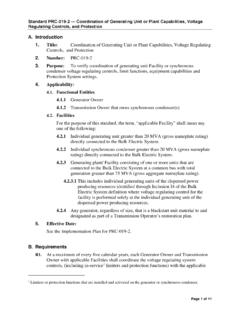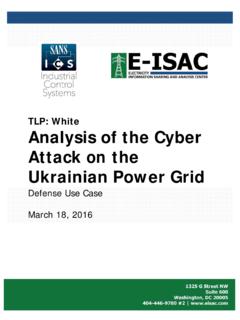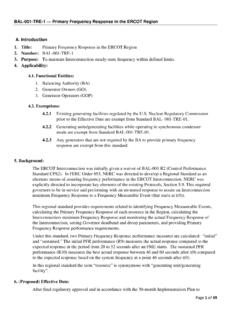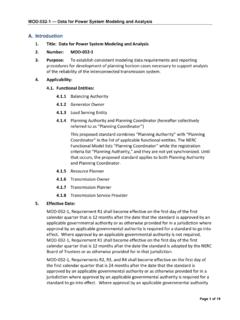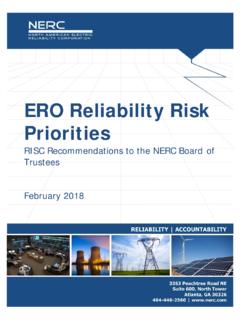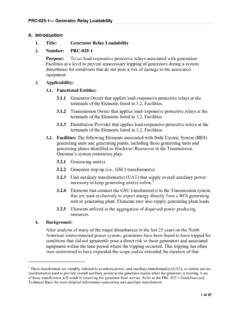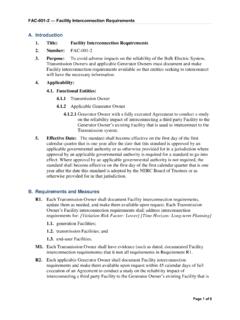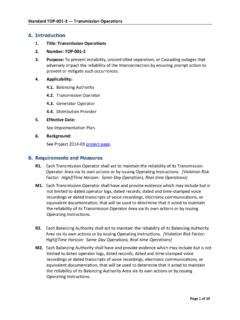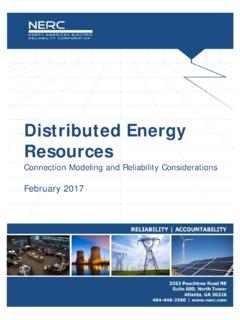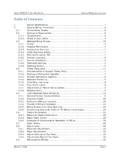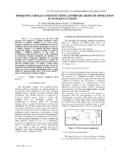Transcription of PRC-023-3 Transmission Relay Loadability
1 Standard PRC-023-4 Transmission Relay Loadability A. Introduction 1. Title: Transmission Relay Loadability 2. Number: PRC-023-4 3. Purpose: Protective Relay settings shall not limit Transmission Loadability ; not interfere with system operators ability to take remedial action to protect system reliability and; be set to reliably detect all fault conditions and protect the electrical network from these faults. 4. Applicability: Functional Entity: Transmission Owner with load-responsive phase protection systems as described in PRC-023-4 - Attachment A, applied at the terminals of the circuits defined in (Circuits Subject to Requirements R1 R5). Generator Owner with load-responsive phase protection systems as described in PRC-023-4 - Attachment A, applied at the terminals of the circuits defined in (Circuits Subject to Requirements R1 R5).
2 Distribution Provider with load-responsive phase protection systems as described in PRC-023-4 - Attachment A, applied at the terminals of the circuits defined in (Circuits Subject to Requirements R1 R5), provided those circuits have bi-directional flow capabilities. Planning Coordinator Circuits: Circuits Subject to Requirements R1 R5: Transmission lines operated at 200 kV and above, except Elements that connect the GSU transformer(s) to the Transmission system that are used exclusively to export energy directly from a BES generating unit or generating plant. Elements may also supply generating plant loads. Transmission lines operated at 100 kV to 200 kV selected by the Planning Coordinator in accordance with Requirement R6. Transmission lines operated below 100 kV that are part of the BES and selected by the Planning Coordinator in accordance with Requirement R6.
3 Transformers with low voltage terminals connected at 200 kV and above. Transformers with low voltage terminals connected at 100 kV to 200 kV selected by the Planning Coordinator in accordance with Requirement R6. Transformers with low voltage terminals connected below 100 kV that are part of the BES and selected by the Planning Coordinator in accordance with Requirement R6. Circuits Subject to Requirement R6: Transmission lines operated at 100 kV to 200 kV and transformers with low voltage terminals connected at 100 kV to 200 kV, except Elements that connect the GSU transformer(s) to the Transmission system that are used exclusively to export energy directly from a BES generating unit or generating plant. Elements may also supply generating plant loads.
4 1 of 15 Standard PRC-023-4 Transmission Relay Loadability Transmission lines operated below 100 kV and transformers with low voltage terminals connected below 100 kV that are part of the BES, except Elements that connect the GSU transformer(s) to the Transmission system that are used exclusively to export energy directly from a BES generating unit or generating plant. Elements may also supply generating plant loads. 5. Effective Dates: See Implementation Plan for the Revised Definition of Remedial Action Scheme . B. Requirements R1. Each Transmission Owner, Generator Owner, and Distribution Provider shall use any one of the following criteria (Requirement R1, criteria 1 through 13) for any specific circuit terminal to prevent its phase protective Relay settings from limiting Transmission system Loadability while maintaining reliable protection of the BES for all fault conditions.
5 Each Transmission Owner, Generator Owner, and Distribution Provider shall evaluate Relay Loadability at per unit voltage and a power factor angle of 30 degrees. [Violation Risk Factor: High] [Time Horizon: Long Term Planning]. Criteria: 1. Set Transmission line relays so they do not operate at or below 150% of the highest seasonal Facility Rating of a circuit, for the available defined loading duration nearest 4 hours (expressed in amperes). 2. Set Transmission line relays so they do not operate at or below 115% of the highest seasonal 15-minute Facility Rating1 of a circuit (expressed in amperes). 3. Set Transmission line relays so they do not operate at or below 115% of the maximum theoretical power transfer capability (using a 90-degree angle between the sending-end and receiving-end voltages and either reactance or complex impedance) of the circuit (expressed in amperes) using one of the following to perform the power transfer calculation: An infinite source (zero source impedance) with a per unit bus voltage at each end of the line.
6 An impedance at each end of the line, which reflects the actual system source impedance with a per unit voltage behind each source impedance. 4. Set Transmission line relays on series compensated Transmission lines so they do not operate at or below the maximum power transfer capability of the line, determined as the greater of: 115% of the highest emergency rating of the series capacitor. 115% of the maximum power transfer capability of the circuit (expressed in amperes), calculated in accordance with Requirement R1, criterion 3, using the full line inductive reactance. 5. Set Transmission line relays on weak source systems so they do not operate at or below 170% of the maximum end-of-line three-phase fault magnitude (expressed in amperes).
7 6. Not used. 1 When a 15-minute rating has been calculated and published for use in real-time operations, the 15-minute rating can be used to establish the Loadability requirement for the protective relays. 2 of 15 Standard PRC-023-4 Transmission Relay Loadability 7. Set Transmission line relays applied at the load center terminal, remote from generation stations, so they do not operate at or below 115% of the maximum current flow from the load to the generation source under any system configuration. 8. Set Transmission line relays applied on the bulk system-end of Transmission lines that serve load remote to the system so they do not operate at or below 115% of the maximum current flow from the system to the load under any system configuration.
8 9. Set Transmission line relays applied on the load-end of Transmission lines that serve load remote to the bulk system so they do not operate at or below 115% of the maximum current flow from the load to the system under any system configuration. 10. Set transformer fault protection relays and Transmission line relays on Transmission lines terminated only with a transformer so that the relays do not operate at or below the greater of: 150% of the applicable maximum transformer nameplate rating (expressed in amperes), including the forced cooled ratings corresponding to all installed supplemental cooling equipment. 115% of the highest operator established emergency transformer rating. Set load-responsive transformer fault protection relays, if used, such that the protection settings do not expose the transformer to a fault level and duration that exceeds the transformer s mechanical withstand capability2.
9 11. For transformer overload protection relays that do not comply with the Loadability component of Requirement R1, criterion 10 set the relays according to one of the following: Set the relays to allow the transformer to be operated at an overload level of at least 150% of the maximum applicable nameplate rating, or 115% of the highest operator established emergency transformer rating, whichever is greater, for at least 15 minutes to provide time for the operator to take controlled action to relieve the overload. Install supervision for the relays using either a top oil or simulated winding hot spot temperature element set no less than 100 C for the top oil temperature or no less than 140 C for the winding hot spot temperature3. 12. When the desired Transmission line capability is limited by the requirement to adequately protect the Transmission line, set the Transmission line distance relays to a maximum of 125% of the apparent impedance (at the impedance angle of the Transmission line) subject to the following constraints: a.
10 Set the maximum torque angle (MTA) to 90 degrees or the highest supported by the manufacturer. b. Evaluate the Relay Loadability in amperes at the Relay trip point at per unit voltage and a power factor angle of 30 degrees. c. Include a Relay setting component of 87% of the current calculated in Requirement R1, criterion 12 in the Facility Rating determination for the circuit. 2 As illustrated by the dotted line in IEEE - IEEE Guide for Liquid-Immersed Transformer Through-Fault-Current Duration, Clause , Figure 4. 3 IEEE standard , Tables 7 and 8, specify that transformers are to be designed to withstand a winding hot spot temperature of 180 degrees C, and Annex A cautions that bubble formation may occur above 140 degrees C. 3 of 15 Standard PRC-023-4 Transmission Relay Loadability 13.
